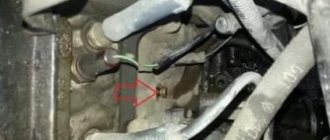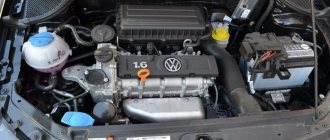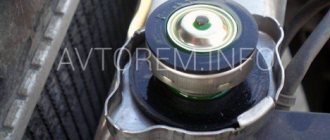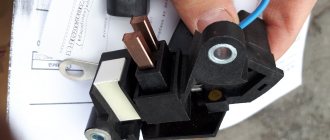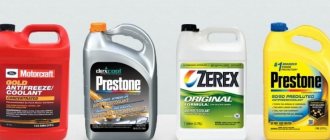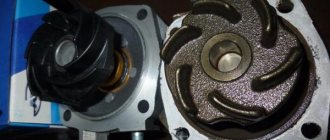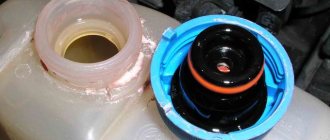Replacement frequency
The vast majority of vehicle owners keep strict records of when to change the engine oil, completely forgetting that the coolant also requires regular updating. This measure is due to a decrease in the quality of antifreeze as a result of operation. In other words, the properties of antifreeze that is used for a long time deteriorate significantly, and the liquid cannot cope with the thermoregulation functions assigned to it.
The average service life of antifreeze ranges from 50-90 thousand kilometers or from 2 to 5 years. This period may be longer or shorter - it all depends on the coolant manufacturer and the operating conditions of the vehicle. If you do not change the antifreeze in time, quite negative consequences are possible:
- After some time, a sediment will form that will clog the engine cooling channels and the heat exchanger itself. This will negatively affect the operation of the radiator: in the summer the engine will constantly overheat, and in the winter there will be difficulties with warming up.
- Since active components continuously evaporate from the coolant, sooner or later the antifreeze will begin to freeze at low temperatures. Subsequently, a slurry will either form in the radiator, or the engine will “defrost” when the cylinder block is destroyed under the pressure of the formed ice build-up.
It is recommended to replace the used cooling mixture before performing repair work. Used antifreeze is drained if you need to replace the pump, radiator or pipes.
Draining old antifreeze
To empty the radiator system, it is not enough to simply turn the tap. As you know, antifreeze is a toxic substance and therefore poses a threat to human health. In this regard, it is important to master important rules for handling it:
- Under no circumstances should you pour antifreeze onto the floor in a garage or on the street, as its toxic fumes can penetrate a person’s lungs and cause severe poisoning.
- Under no circumstances should antifreeze be allowed to come into contact with mucous membranes. If the substance accidentally gets into your eyes or exposed parts of the body, you should immediately rinse these areas under running cold water.
- After completing work related to replacing the coolant, wash your hands thoroughly.
To get rid of old coolant , you need to prepare a large container in advance. It is desirable that it has a wide cavity and a shallow bottom. The fact is that the space under the car is limited, but there is plenty of space in the width. For this reason, car owners most often use a regular aluminum pan for such manipulations.
When all the devices are ready, remove the engine protection, if any. In those salons where there is a stove with mechanical adjustment, the lever is moved to the position corresponding to the maximum temperature. To prevent a vacuum from forming in the system, some people prefer to remove the cap of the expansion tank, but, as practice shows, this often results in liquid splashing.
Next, placing a container under the cooling device, carefully unscrew the radiator drain plug, being careful not to flood the generator and other electrical equipment. But the main thing, of course, is not to damage the heat exchanger honeycombs, because welding them will be very problematic. As soon as all the liquid has been drained, proceed to draining it from the engine.
Move the aluminum trough under the engine and slowly unscrew the drain plug of the cylinder block. Wait for the antifreeze to settle, and after about 15 minutes screw everything back in.
Radiator flushing
Anyone who wants to learn how to properly change antifreeze in a car should pay attention to all stages of this process without exception. Before adding new antifreeze, it is necessary to remove scale from the walls of the cooling system. Car enthusiasts have long noticed that a lot of scale forms when antifreeze is diluted with distilled water.
A radiator that has not been touched for a long time is usually full of dirt and oil deposits. The most basic way to clean the cooling system is to fill it with plain water. After the car has been driven on such fluid for at least one day, it is drained. It is useful to pay attention to the color in which it is painted. If the water becomes very cloudy, you should think about flushing the system again.
You can use a citric acid-based anti-scaling agent. After pouring it into the system, start the engine and let it run for a few minutes, then drain the cleaning solution. Specialized stores offer a wide range of anti-scale preparations in powder form.
Filling with new coolant
To properly change antifreeze without getting burned, you need to wait until the engine cools down and only then start working. It is important to understand what kind of liquid will be poured into the radiator. Experienced auto mechanics strongly recommend that you first familiarize yourself with the classification of coolants and study the detailed characteristics of individual types of antifreeze in order to understand what type of antifreeze is suitable for a particular brand of car.
If antifreeze concentrate is used when replacing, then before filling it is diluted with distilled water in a 1:1 ratio. With this proportion, it will not lose its properties even in the most severe frost.
To avoid the formation of air pockets in the cooling system, the vehicle is positioned in a strictly horizontal plane, after which antifreeze can be poured. Radiator fluid is replaced by following the following algorithm:
- Disconnect the upper pipe through which antifreeze is supplied to the engine. Typically, it is located next to the intake manifold.
- Using a funnel, coolant is poured through the neck of the expansion tank.
- Antifreeze does not stop pouring until it begins to flow out of the previously disconnected pipe.
- Place the pipe in its original place and clamp it with a clamp.
- Pour antifreeze into the expansion tank up to the max mark, then close it tightly with a stopper.
Replacing the coolant: how to change antifreeze correctly
The liquid poured into the car’s cooling system ensures the uninterrupted and correct operation of the elements of the engine unit. And from time to time every motorist faces the question of replacing it. It is better if you know how to replace the coolant. This will save money on performing this procedure at a car service center and will protect the car owner and his car from the dishonesty of his craftsmen (which, unfortunately, occurs quite often). Today we will describe in detail the sequence of actions when changing coolant .
How to distinguish antifreeze from antifreeze - let's understand the chemistry
The properties of antifreeze and antifreeze are determined by a set of additives. Moreover, even the color of a liquid can tell us a lot about its quality characteristics. The most important difference between additives is their nature; in domestic antifreeze they are inorganic, while in imported antifreeze they are organic. This cannot but affect the service life and quality of the fluid itself and its relationship with the engine cooling system. In addition, this leads to the fact that the boiling point, density of antifreeze and antifreeze are also slightly different.
Let's briefly go through all the indicators. Antifreeze is less perfect than imported antifreeze, therefore it forms an anti-corrosion layer over the entire area of the system so that its aggressive components do not burn the walls, which makes the metal transfer heat worse and reduces the efficiency of the entire process. Because of this, the engine suffers, its wear accelerates, and fuel consumption increases. Antifreeze loses its properties after 35 thousand km. An imported product acts “smarter”. It forms a protective layer only in problem areas, and not over the entire surface, so heat transfer remains at a high level, engine problems become less likely, and the coolant will need to be changed only after 250 thousand km.
The color of the liquid tells us what the boiling point of antifreeze and antifreeze is. This also allows you to avoid confusion when purchasing a new batch of liquid, because you can only mix the same colors.
Why change the coolant?
Without a coolant, correct operation of a car engine and operation of the vehicle . Below we will explain how to change antifreeze (antifreeze), but first you need to dwell on why you need to do this in the first place.
Coolant replacement
Today there is a huge range of products available for sale that are intended for pouring into the cooling system. The driver can only choose the best option and regularly replace the coolant. This will insure you and your car against serious problems. Including:
- Corrosion processes. In addition to corrosion damaging the metal parts of the system, it becomes an obstacle to proper heat exchange directly in the system and in the power unit. At the same time, corrosive layers in the radiator channels reduce the rate of coolant circulation and reduce correct heat transfer.
- Overheating of the power unit. If heat exchange in the engine is disrupted, the likelihood of overheating increases. This leads to increased fuel costs and decreased engine power.
- Precipitation. Typically, this “suffers” from antifreezes that have silicate components in their composition. Failure to replace these products on time results in the formation of insoluble sediment on the surfaces inside the system, which causes overheating of the engine.
- Appearance of cracks. If the coolant is excessively diluted due to sudden temperature changes, cracks appear on the surfaces of the expansion tank and pipes.
- Erosion processes of cavitation type. Cavitation is a process occurring inside a system in which gas bubbles form and burst due to a decrease in pressure. The internal surfaces of the system are damaged at the molecular level when gas bubbles collapse. High-quality coolant forms a protective film that prevents erosion.
What is the difference between antifreeze and antifreeze - historical outline
There is undoubtedly a difference between antifreeze and antifreeze. And we will talk about this throughout our article. Let's start with a little look into the past. There was a time when there were no foreign cars on our roads yet, and the country had a curtain on any import, including consumables for cars. Our industry could produce everything itself; it did not ignore the coolant. Antifreeze is an exclusively Soviet product, and is essentially antifreeze, because it acts in exactly the same way. Only earlier it was a proper name, even an abbreviation, and then it became a common noun and brings discord into the heads of novice car owners.
The difference between antifreeze and antifreeze is visible already at the development stage; their composition was invented independently, although the typical mixture was taken as a basis - alcohol (ethylene glycol) and distilled water. The essence of selecting the main components is simple: alcohol lowers the freezing threshold of water, which allows you to cool the engine even in cold weather, and the upper temperature threshold is determined by the properties of water, i.e. The composition will boil at about 100 degrees. But the set of additives is the main difference. The composition of antifreeze and antifreeze includes additives and dyes of different nature, hence the slightly different properties for each of them.
Replacement frequency
Before we talk in detail about how to change the coolant in a car, let’s focus on the regularity of this procedure. There are general recommendations regarding the frequency of replacing the refrigerant - approximately once every 24 months or every 45,000 km. The period for replacing the coolant is determined based on factors such as the technical condition of the car and its actual mileage, the brand and composition of the coolant itself, as well as the product used previously.
Fluids with silicate additives must be replaced every 24-36 months. Combined formulations lose their working properties after 36-60 months, and products with a carboxylate base can “work out” for more than 5 years.
How to replace antifreeze
Today there are carboxylate compounds that are designed for a mileage of 100,000 km or more, but their range is not yet so diverse.
But often, the coolant loses its performance qualities somewhat earlier than the deadline . That's why you need to check its condition sometimes. Here are several options that allow you to accurately determine that it is time to replace the coolant:
- using a special test strip - this is the most reliable and affordable way (you can buy it together with the coolant): “litmus”, immersed in the solution, changes color, which makes it clear how long the fluid will last before being replaced (a color scale is usually attached to the test);
- coolant density, which changes in the spent mixture;
- color of the working composition - coolant that has lost its properties, does not have a bright color, becoming more faded/cloudy (at the same time, a red/reddish tint indicates the presence of rust in the coolant and the use of such a composition is extremely undesirable);
- the presence of clots, foam, flakes and scale, as well as sedimentation or the formation of a mushy mass inside the expansion tank is a clear sign that the coolant needs to be changed.
The suitability of the coolant can be easily determined visually or using special means. Timely replacement of the fluid helps maintain the good condition of the power unit cooling system and avoid expensive car repairs.
How to change antifreeze
When to replace
First of all, it is important to understand when to perform such a procedure. Most auto mechanics advise replacing antifreeze at least every 24 months. This especially applies to vehicles with a cylinder head and radiator made of aluminum. In addition, the technical documentation indicates the maximum period for the operation of the coolant.
For example, on Ford cars the manufacturer sets 240 thousand km. mileage, on Mercedes - five years, etc. In domestic models, this period is usually 2-3 times less. Long antifreeze service life is achieved through the use of innovative coolants with an improved formula.
In addition, it is necessary to carry out such a procedure if the liquid changes color, becomes cloudy, or a precipitate begins to form. You also need to change the antifreeze after repairing the power unit and adding fresh material there (this prevents its corrosion).
At the same time, it is advisable to use the original composition, so when choosing a product, follow the manufacturers’ instructions.
Coolant replacement stages
Knowing how to replace the coolant in a car, every car owner will be able to cope with all the steps independently. We emphasize that the sequence for replacing the coolant is similar for all cars :
- The spent working composition must be completely drained.
- Thoroughly flush the power unit cooling system.
- Pour in new working mixture.
Draining the used refrigerant
To completely drain (without any remaining) coolant, it is advisable to lift the rear of the car . To do this, you can use a jack, but other improvised means may also work.
Having lifted the rear of the car, you can proceed directly to draining the coolant. Almost all power units have a special tap or drain hole at the bottom with a securely fixed plug. It is through this element that the coolant is drained from the cylinder block. In addition, it is necessary to remove coolant from other parts of the system - the radiator and expansion tank. This is done as follows:
- Loosen the expansion tank cap - this allows the working mixture to flow out faster.
- Roll up the plug for draining the working fluid from the engine cooling jacket into a container prepared in advance, placing it under the drain hole.
- Unscrew the drain valve (remove the plug at the bottom of the radiator) - this allows you to remove the coolant from it.
- The coolant pressure can be adjusted by unscrewing/tightening the expansion tank cap. After finishing draining the working mixture, return all drain elements to their place.
Important! Before you start draining the coolant, you need to “de-energize” the car by disconnecting the battery!
Cooling system
Let us remind you that there is a special drain valve on the radiator, but you can get to it only after dismantling the bumper. And if we talk about AWT or AZM power units, then to drain the working fluid, you need to dismantle the thermostat by unscrewing the elements securing it. Having finished draining the coolant, the thermostat must be returned to its place, and the fasteners must be tightened taking into account the prescribed tightening torque.
Causes of fluid leakage
If the engine begins to overheat and steam is coming from under the hood, then perhaps the problem is a coolant leak. To eliminate these signs, you need to understand the causes of engine leakage:
- Moisture on the pipe . The fastener has become loose, causing antifreeze to slowly drip from underneath it. To quickly eliminate the cause of the leak, the clamp can be moved higher than the previous fastening.
- The radiator has failed . Another reason for fluid leakage. To determine the failure of the radiator, you need to take into account a number of symptoms. First of all, carefully inspect the surface of the radiator. A puddle may also form on the front seat carpet. In such a situation, the radiator is replaced with a new one.
How to change antifreeze to antifreeze?
How to properly replace antifreeze with antifreeze in a car?
Step-by-step instructions for the replacement procedure:
- The car is set to the parking brake and the power unit is allowed to cool to a temperature comparable to the environment.
- The expansion tank cap is opened, a drain container is inserted, and the radiator drain plug is opened.
- All plugs are screwed back in and a special additive or distilled water is poured in for rinsing.
- The expansion tank cap is screwed on and the car is started to warm up to 90-100 degrees Celsius.
- The car's power unit is switched off and time is given to cool down.
- The expansion tank cap and the radiator drain plug are unscrewed again.
- The drain plug is screwed in and antifreeze is poured.
- The vehicle's power unit is heated to the required temperature and coolant is refilled to the required level.
Each liquid, be it antifreeze or antifreeze, has its own characteristics and disadvantages. Therefore, each owner chooses for himself what to pour into the cooling system.
Replacing antifreeze with antifreeze in a car cooling system
This option is quite common. For many years, our compatriots knew only one coolant - antifreeze. At the same time, everything is changing, and new formulations have appeared on the market.
You don’t need to think that antifreeze is radically different from antifreeze. In fact, the second is the global name for cooling compounds, while antifreeze is a domestic trademark of such products. As a result, the process of replacing antifreeze with antifreeze must be done exactly as with any other liquid.
So, we figured out when it is necessary to change the fluid, and also whether it is necessary to flush the cooling system when replacing antifreeze with a new one. It is worth noting that the procedure itself is quite easy. So, by following all the necessary rules, you can significantly extend the life of the power unit in your vehicle.
Stages of replacing coolant VAZ 2104
On most classic Lada cars, drainage is provided from the radiator, as well as the engine. But before adding new antifreeze, it is recommended to flush the cooling system to prevent impurities from getting into the new liquid.
During the production of the VAZ 2104, a large number of modifications were produced, which were equipped with various engines. But at the moment the most popular are gasoline versions in carburetor and injector versions.
Before you start replacing the coolant, to avoid getting burned, you need to wait until the engine has completely cooled down. You should also avoid getting antifreeze or antifreeze on the skin, eyes or digestive organs, since the chemical composition of the liquids is toxic.
Coolant drain
Before starting the draining procedure, you should prepare tools, containers for used antifreeze, as well as new liquids for subsequent refilling. If protection is installed under the engine, it can also be removed for convenience.
Next, we perform the procedure for draining the liquid from the VAZ 2104:
- Turn the temperature regulator in the cabin to the maximum position to the right (Fig. 1).
Flushing the cooling system
If there are deposits in the drained liquid or there is a transition from antifreeze to antifreeze, the system should be flushed. To do this you need to do the following:
- Flush the system with plain water through the expansion tank of the VAZ 2104. The plugs must be open;
- tighten the drain plug and bolt;
- fill the system with a flushing agent (you can use Liqui Moly Kuhlerreiniger or Lavr cooling system flush) with distilled water (6-7 liters);
- start the engine. Warm up to 90 degrees;
- leave it idling for 5-10 minutes, depending on the contamination of the system;
- muffle it. Allow the engine to cool to approximately 60 degrees;
- drain the flush using the same steps as removing the old fluid;
- tighten both plugs;
- fill with distilled water to rinse the cooling system;
- start the car and warm up to 90 degrees;
- turn off and let cool to 60 degrees, drain;
- repeat steps 8, 9, 10 and 11 if necessary.
Filling without air pockets
To fill new fluid into the cooling system, you can use the instructions described in the book on car repair and operation. But when doing this, motorists very often end up with air jams.
So, let's start filling it correctly:
- If you have an injector, then remove one of the hoses going to heat the throttle assembly (Fig. 6).
Thus, the filling of coolant without the formation of air pockets is completed. All that remains is to wipe off the spilled antifreeze and wait for the engine to cool. With the car now cooled down, check the level in the expansion tank again and top up if necessary.
Is it possible to mix antifreeze and antifreeze?
Is it possible to mix antifreeze and antifreeze, coolant classes G11 and G12, is it worth flushing the engine after that?
You can find conflicting information on various forums, some say you can mix, others not. Some started having problems after mixing, while for other car owners everything was fine.
Before answering the question of whether mixing different types of coolants is allowed, we highlight the following points:
- It is prohibited to rely on color when considering whether to mix coolant or not. There is no guarantee that the manufacturer followed the rules. Most often, the coolant shade is chosen not based on classification, but to attract customers, for advertising purposes, or to facilitate troubleshooting.
- It is allowed to add the same type of antifreeze to the system. So, if G11 is already present in the cooling system, then it is worth adding it. If G12, then it is recommended to fill it with G12.
- When mixing, it is worth considering the composition of the consumable material and the type of additives. Each manufacturer adds a specific set of additives to its product - anti-foam, anti-corrosion and others. Today, there are dozens of types of additives, which complicates the mixing of certain compounds. If you thoughtlessly pour coolant into the system, you can get a “mix” of additives that will not help the engine, but will ruin it.
- It is prohibited to mix antifreeze with antifreeze due to the different composition. Thus, domestic coolants have an aggressive effect on the cooling system due to the presence of silicate in the composition. As for antifreeze, it does not contain this element, but there is a wide range of other additives.
- It is forbidden to mix antifreezes that are part of the silicate-free group.
When replacing one element with another, it is recommended to flush the cooling system using a special composition. If this is not done, the metal elements of the engine will quickly rust.
In addition, sediment accumulates in the system, clogging the channels and impairing the beneficial properties of the coolant. In this case, mixing is allowed if the liquids have an identical composition but a different color.
Replacement frequency, what antifreeze to fill
According to the manufacturer's recommendation, it is necessary to replace antifreeze or antifreeze on VAZ 2104 cars every 2 years or after a mileage of 60 thousand kilometers. If the car is used in more severe conditions, then it is advisable to replace it more often - every 30-40 thousand kilometers.
In addition to the recommended coolant change intervals, there are other reasons why it is necessary to change the fluid in a car's cooling system:
- Loss of properties. You can check the quality of the antifreeze used using a test strip, which is sold in the same places where the liquid itself is sold. Place the strip in the expansion tank, then pull it out. The strip comes with a color scale, according to which you can understand how much longer the car can be used before replacing the coolant.
- Change in color to red or red. This means that rust has appeared in the composition.
- The appearance of sediments, flakes and dense formations.
As a coolant for the VAZ 2104, you can use good Lukoil antifreeze. Or a lesser-known but high-quality product from Gazprom Neft. When replacing, you can also fill in antifreeze, preferably with G12 approval, it is safer for the entire system. You can also use original Lada G12 antifreeze, which is suitable for all cars of this manufacturer.
How to choose antifreeze
Before replacing antifreeze, you must first buy it. Oddly enough, this can also cause problems. After all, it comes in different brands, as well as different characteristics, and not every car owner knows which ones are suitable.
Here are the important points to pay attention to when choosing a coolant:
- Marking. First, let's look at the conventions. Any antifreeze is marked with a letter and a number. There can be two letters: “A” - ready to be poured into the cooling system, “K” - means a concentrate that requires dilution before use. After the listed letters, the freezing temperature is placed on the Celsius scale - 40, 65 degrees, etc. After this, at the end, there may be the letter “M”, which indicates the presence of additional impurities and additives. Sometimes the label just shows a name and a number.
Antifreeze markings
There is also some “unofficial” but common marking introduced by Volkswagen. In accordance with it, antifreeze is divided into groups G11, G12 (G12+, G12++) and G13.
G11 - mainly green antifreezes, which contain organic and chemical additives;
Antifreeze G11
- G12, G12+, G12++ are red antifreezes of various shades, they are almost completely organic;
Antifreeze G12, G12+, G12++
- G13 - basically purple or yellow antifreeze, more modern and safer.
Antifreeze G13
Not all antifreezes of different markings can be mixed with each other. In any case, the seller will tell you about the product you are buying, so there will be no problems with this.
Mixing antifreeze of different markings
Manufacturer
You also need to pay attention to this, since you may get a defect that will ruin your engine. To prevent this from happening, you need to buy antifreeze from trusted or at least well-known companies
For example: Liqui Moly, Lukoil, Hepu, Motul, Mobil.
It is recommended to buy antifreeze only from proven brands
Detection of counterfeits. It often happens that recently purchased antifreeze very quickly became unusable or, more simply put, you came across a fake. But how to choose a good product? Easily! There are basic parameters that are common to all coolants. First of all, this is the color: it must match the markings (the standard color is blue) and be transparent, but only slightly. In addition, the consistency of the substance should be slippery and resemble vegetable oil. You also need to pay close attention to the label. At factories they glue it evenly and indicate GOST and markings on it. By the way, all domestic manufacturers comply with these requirements. The brand must be in line with GOST. In other cases, you will most likely buy a defect.
Original antifreeze (left) and fake (right)
Another important point worth mentioning is the name. The coolant container may be labeled “Tosol” or “Antifreeze”. What is the difference between them? Nothing! Simply, the word “antifreeze” can be used to describe any substance that is capable of removing heat, and antifreeze is produced exclusively for cars and, in particular, for internal combustion engines, since it has anti-corrosion properties, thanks to which the block and cooling system are not damaged.
